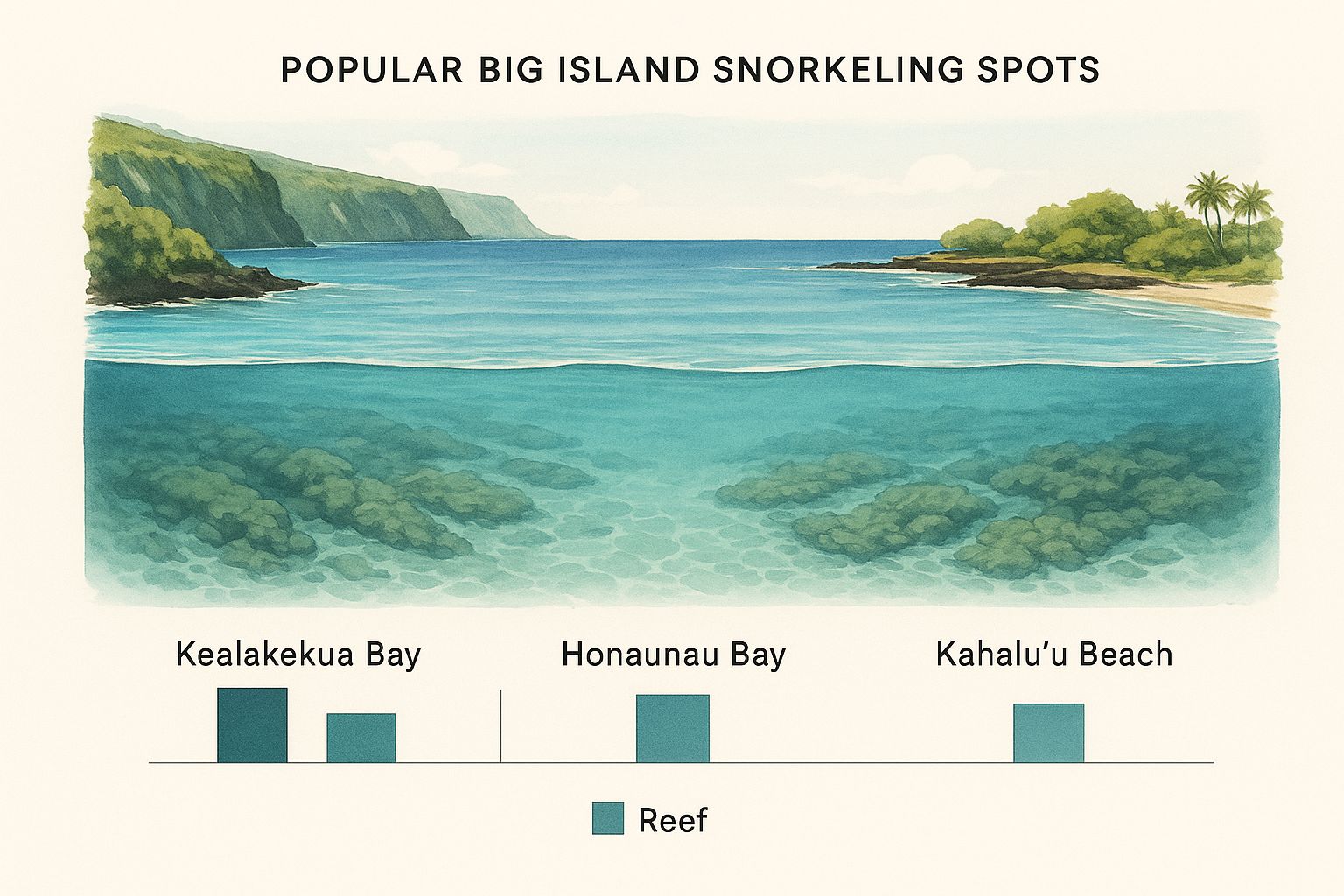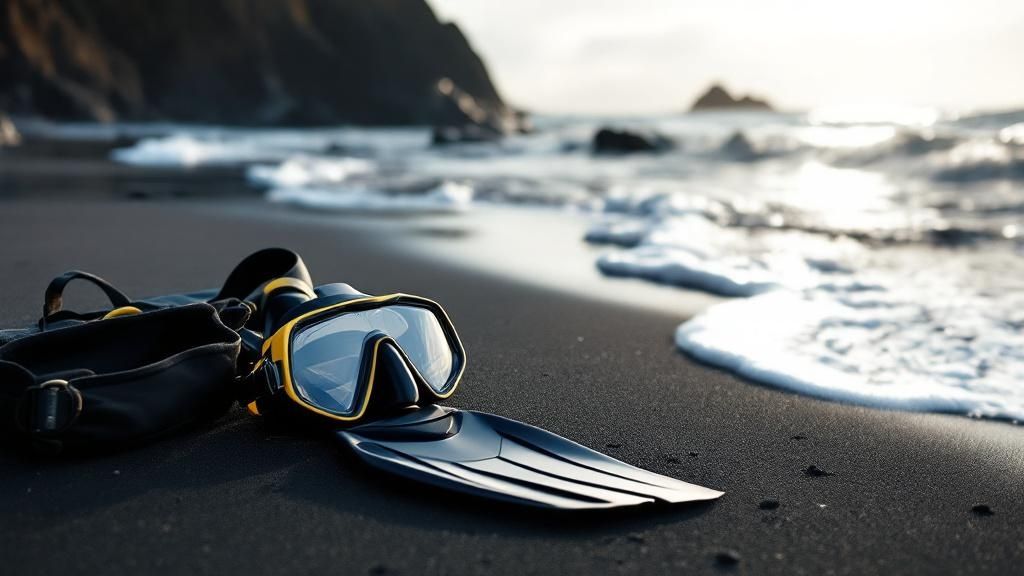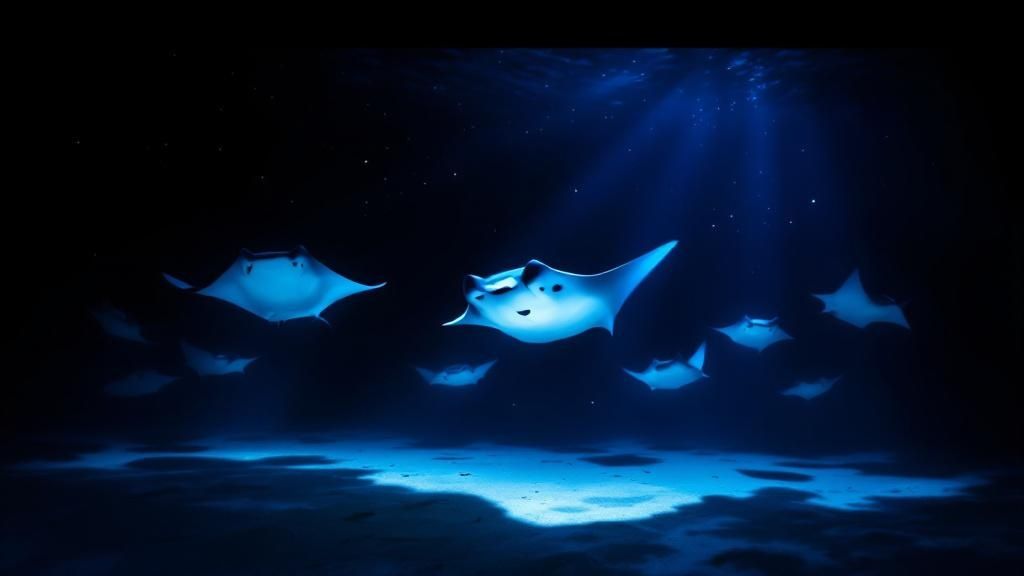Your Guide to Manta Ray Snorkel Big Island Adventures
- Byron
- Jul 25
- 11 min read
There are few wildlife encounters on the planet that can truly change you. A manta ray snorkel on the Big Island is one of them. Floating in the dark, peaceful Pacific as giant, graceful manta rays glide and somersault just inches below you is a magical experience that's hard to put into words.
Your Guide to a Big Island Manta Ray Encounter
Welcome! This isn't just a guide to checking another item off your vacation list. This is about preparing you for a profound, almost spiritual connection with the gentle giants of the ocean. It’s one thing to read about it, but seeing is believing. Our guests at Manta Ray Night Snorkel Hawaii constantly share their awe-inspiring stories, and we want you to have one of your own.
This journey really begins with understanding what makes this encounter so special. Kona's unique underwater landscape has created the perfect dining spot for manta rays, making it the most reliable place in the world to see them.
Think of this as your complete playbook. We'll walk you through everything you need to plan, prepare, and fully soak in this incredible activity. From picking the right tour to what it actually feels like in the water, we’ve got you covered.
Why Kona is the Manta Ray Capital of the World
The Big Island of Hawai'i, and the Kona Coast specifically, is famous worldwide for its incredible manta ray population. Researchers have identified over 450 individual reef manta rays right here, which is why Kona has earned its nickname as the 'Manta Ray Capital of the World.'
So, what's the secret? It's all thanks to the island's volcanic origins. The unique underwater topography creates nutrient-rich upwellings that attract huge amounts of plankton—the manta rays' primary food source. This natural buffet brings a high concentration of mantas to specific feeding sites like Manta Village and Manta Heaven.
Because of this, night tours along the Kona Coast have an unbelievable 85-90% sighting success rate, with guests seeing an average of three mantas per trip. You can dive deeper into these incredible Kona manta ray statistics and what makes our spot so perfect for sightings.
This isn't just a tour; it's a chance to witness a natural spectacle. The experience is all about passive observation. You get to float peacefully while the mantas perform their underwater ballet right below you.
Ready to book this bucket-list adventure?
For a full breakdown of planning your trip, don't miss our ultimate guide for unforgettable manta ray snorkeling. And if you're looking for more inspiration, you can get great tips for making mindful memories on other Hawaiian islands. You can also learn more about our world-class tours on our homepage.
How to Choose Your Perfect Manta Ray Snorkel Tour
Picking the right manta ray snorkel on the Big Island isn't just a small detail—it's the single most important decision you'll make for turning a good trip into a legendary one. I've seen it time and time again: not all tours are created equal. Things like the size of the boat, where it departs from, and the company's commitment to sustainability can completely shape your experience.
Before you even think about booking, it’s crucial to understand what sets a great tour apart. You're not just buying a ticket; you're choosing your guides for what is truly one of nature's most spectacular ballets.
Let's break down the key things you need to consider to find the perfect fit for your adventure.
Comparing Manta Ray Snorkel Locations
On the Kona coast, the action is centered around two main sites: Manta Village and Manta Heaven. Each has its own vibe and offers a slightly different experience.
When choosing between the two primary manta ray snorkeling locations, it's helpful to see their features side-by-side. Both offer incredible opportunities, but one might be a better fit for your group depending on your priorities.
Manta Ray Snorkel Tour Comparison
Feature | Manta Village (Keauhou Bay) | Manta Heaven (Near Airport) |
|---|---|---|
Sighting Success Rate | Consistently 95% or higher | Very high, around 90% |
Location | South of Kona | North of Kona (Garden Eel Cove) |
Boat Ride Time | Very short, often under 10 minutes | Longer, around 20-30 minutes |
Best For | Families, those prone to seasickness | Adventurous visitors, larger groups of mantas |
Key Advantage | Quick access, extremely reliable sightings | Potential for more mantas in one spot |
Essentially, your choice comes down to a trade-off: a shorter, more convenient boat ride with near-guaranteed sightings at Manta Village, or a slightly longer journey to Manta Heaven with the potential for an even bigger spectacle.
This image gives you a fantastic perspective of what these Big Island snorkeling spots look like, showing the clear water and reef structures that make them ideal manta habitats.

Tour Operator Style: Boat Size and Vibe
Once you have a location in mind, the next step is thinking about the kind of boat you want to be on. Tour operators here run the gamut from large, stable vessels with more amenities to smaller, faster rafts like Zodiacs.
A bigger boat is often a great choice for families with kids or anyone who wants a more relaxed journey. They provide a much smoother ride and give you more space to move around before and after you get in the water.
On the other hand, a smaller raft delivers a more intimate and adventurous feel. The ride can be a bit bumpier and more exhilarating, but with fewer people on board, you usually get more one-on-one attention from the guides. If you want to explore this topic more, you can learn about what to expect on this Hawaiian underwater adventure.
One of the most critical things to look for is whether a tour operator is "Manta Ray Green Listed." This certification isn't just a sticker; it's a sign of a company’s deep commitment to responsible tourism. They follow strict guidelines to protect the mantas and their habitat, ensuring your adventure helps with conservation.
Ultimately, finding your perfect tour is about balancing the right location, your comfort level, and a shared commitment to protecting these magnificent animals for years to come.
Getting Ready for Your Manta Ray Night Snorkel

A little bit of prep work can turn a great manta ray snorkel on the Big Island into an absolutely magical, once-in-a-lifetime memory. When you know what to bring, what to wear, and how to act in the water, you can relax and focus completely on the gentle giants gliding right below you.
We've found that our guests at Manta Ray Night Snorkel Hawaii always have the best time when they show up ready for the adventure ahead.
First things first, let's talk clothing. You’ll be on a boat, on the ocean, at night. Even in paradise, it can get surprisingly chilly after you get out of the water. The easiest approach is to wear your swimsuit under your regular clothes when you head to the marina. That way, you're ready to go!
And trust me, after your snorkel, that boat ride back can feel brisk. You will be so glad you brought warm, dry layers to change into. A cozy sweatshirt or a simple windbreaker is a game-changer.
What to Bring (And What to Leave Behind)
Packing the right stuff makes all the difference. While we provide all the essential snorkel equipment, a few personal items will make you much more comfortable.
A Towel: A quick-drying travel towel is perfect for this.
Dry Clothes: Don't forget a full change of clothes, especially a warm top layer.
Waterproof Camera: Got a GoPro or another underwater camera? Absolutely bring it!
Seasickness Medication: If you even think you might get motion sickness, it's best to take medication before you get on the boat. Better safe than sorry.
It’s just as important to know what not to bring. Try to leave valuables or anything that isn’t waterproof back at your hotel unless you have a high-quality dry bag.
Crucial Rule of Engagement: Passive Observation The absolute number one rule for any manta ray encounter is to never, ever touch the mantas. These amazing animals have a protective mucous layer on their skin that acts like their immune system. Touching them can strip this layer off and cause them serious harm. Remember, we are just respectful visitors in their home.
The Most Important Thing to Remember
The golden rule for a responsible and breathtaking manta tour is passive observation. You'll be holding onto a floating light board, which is what attracts the plankton the mantas come to eat. Your only job is to float, watch, and be completely mesmerized as they swoop and barrel roll right beneath you.
Chasing them or trying to "pet" them is strictly forbidden and ruins the experience for everyone. For a deeper dive into this and other pro tips, check out our ultimate guide with more Big Island manta ray snorkel tips.
Feeling prepared for the night of your life? Book your spot and get ready for an unforgettable adventure.
What to Expect During Your Manta Encounter
This is the part everyone talks about—the real magic. After a short boat ride, the engines will cut, and you'll feel a jolt of pure excitement. You’ll slip off the boat and into the surprisingly warm, dark Pacific waters. The sounds from the world above disappear, replaced by the peaceful, muffled hum of the ocean at night.
Your guide will lead you over to a large, custom-built light board. This isn't just something to hold onto; it’s the key to the whole experience.
This floating raft has powerful lights that beam straight down into the water, creating a glowing stage in the vast darkness. This light is an irresistible magnet for microscopic plankton, which swarm into the beams. And where there's a plankton feast, the manta rays are sure to follow.
The Underwater Ballet Begins
At first, all you might see are the tiny plankton swirling like underwater snow in the light. But then, you’ll spot it—a massive shadow emerging from the deep blue. That first glimpse is something you’ll never forget. A manta ray glides effortlessly into view, its huge wings propelling it with an elegance that just doesn't seem possible for a creature of its size. This is the heart of the manta ray snorkel Big Island experience.
Before you know it, another one joins, and then another. They perform a mesmerizing underwater ballet, soaring and barrel-rolling right below you to scoop up mouthfuls of plankton. It’s common for them to come within inches of your mask, their huge, intelligent eyes seemingly looking right back at you. You can get an even better idea of what to expect by reading up on the Kona manta ray snorkel experience.
It's an overwhelming feeling of pure awe. You are a silent, respectful guest in their world, witnessing a nightly feeding ritual that has been happening for generations. The experience is both a massive thrill and incredibly humbling.
Positioning and Safety On The Light Board
To get the best possible view and ensure the encounter is safe and respectful for both you and the mantas, listening to your crew is key. They know what they’re doing.
Hold On and Float: Get a comfortable but firm grip on the handles of the light board. Let your body float horizontally behind you, kind of like you're doing the "Superman" pose.
Keep Your Feet Up: This is a big one. Avoid kicking or letting your legs dangle down into the manta's "dining room." This keeps you out of their way and prevents any accidental contact.
Stick Together: The light board is where all the action is. Drifting away from the group means you'll miss the show and could create a safety concern for the crew.
By staying calm and still, you help the mantas feel secure. This encourages them to come closer and put on an even more spectacular show. You've got a front-row seat to one of nature's greatest performances.
Why Protecting Hawaii's Manta Rays Matters

Watching these gentle giants perform their nightly underwater ballet turns a manta ray snorkel on the Big Island from a fun activity into something truly meaningful. It's a real connection with nature. To get the most out of it, it helps to understand who these amazing animals are and why they count on us for protection.
The reef manta rays you'll meet aren't just passing through. They are a resident population, with many individuals living their entire lives right here along the Kona coast. That makes your experience incredibly special, but it also shines a light on just how fragile their existence is.
Our team at Manta Ray Night Snorkel Hawaii is passionate about sharing our knowledge with every guest, and the amazing feedback we get tells us it makes a difference.
Understanding Manta Biology and Vulnerability
Manta rays are remarkably smart, boasting the largest brain-to-body size ratio of any fish. But they have very slow reproductive rates, often giving birth to only a single pup every 2 to 5 years. This slow pace means their populations can take a long, long time to recover from any harm.
Because they stay local, the population around the Big Island is also genetically isolated. These are truly our mantas, and they depend completely on the health of our specific coastal ecosystem to survive. For more answers to common questions, take a look at our detailed manta ray FAQ page.
By choosing a responsible tour, you're not just a tourist; you become a steward of the ocean. Your mindful presence helps fund and encourage conservation efforts that protect these animals for generations to come.
This simple choice transforms your vacation adventure into a positive force for Hawaii's marine life.
Threats Facing Hawaii's Manta Rays
Despite being local celebrities, manta rays here face a number of human-caused threats. Their slow-growing populations are hit hard by risks like:
Entanglement in fishing gear
Accidental boat strikes
Degradation of their coral reef habitats from coastal development
Ingestion of microplastics
Disturbances from unregulated or irresponsible tourism
This is exactly why following safe viewing guidelines is so important. When you choose a sustainable tour operator and stick to the passive observation rules—no touching, no chasing, and staying on the surface—you actively help protect them.
Your adventure becomes more than just a tour; it's a vote for preserving one of the ocean's most magnificent creatures.
Ready to be part of a respectful and awe-inspiring experience?
Your Manta Ray Snorkel Questions Answered
Feeling a few butterflies before your big manta ray snorkel on the Big Island? That’s totally normal! We find that knowing exactly what to expect helps our guests relax and really soak in the magic of the experience. The team at Manta Ray Night Snorkel Hawaii wants you to feel confident and, most of all, excited for your tour.
Let's dive into some of the most common questions we hear from first-timers.
Common Concerns and Clear Answers
You're not alone in wondering about these things. Let's get them answered so you can look forward to the main event!
Is it safe to swim with manta rays? Absolutely! Manta rays are called "gentle giants" for a very good reason. They are filter feeders, dining on microscopic plankton, not people. Unlike their stingray cousins, they have no stinger, barb, or teeth, making them completely harmless to us.
Do I have to be a strong swimmer? You just need to be comfortable in the water. There's no need to be an Olympic-level swimmer! You'll be holding onto our custom-built, floating light board the entire time. The board gives you all the stability you need, so your main job is just to float, watch, and be amazed.
What if no manta rays show up? It's a valid question—these are wild animals, after all. But the good news is that sightings are incredibly reliable, often with a success rate over 90%. In the rare event the mantas are a no-show, most reputable tour operators (including us!) have a "manta guarantee." This usually means you can re-book for another night, free of charge.
The Best Time to Go and Manta Genetics
We often get asked about the "best" time of year for a tour. The fantastic answer is that there isn't really a "manta season" in Kona. The mantas here are a resident population, meaning they live here all year and show up to their favorite feeding spots almost every single night.
This local residency is exactly why their conservation is so important. Genetic research has shown that the reef manta populations in Hawai'i are small and very isolated. In fact, the mantas on the Big Island are genetically distinct from those on other islands, with each population numbering only a few hundred individuals. Females almost never leave their home island, making these groups especially vulnerable to local threats. You can read the full research about these manta findings to learn more.
This genetic uniqueness underscores the importance of choosing a sustainable tour. When you snorkel with a responsible operator, you're not just having an adventure; you're supporting the protection of a truly unique and irreplaceable local population.
On a lighter note, it’s always interesting how words take on new meanings. While we’re talking about exploring the ocean, you might find it funny how the term 'snorkel' has other uses in completely different fields, like off-road vehicles.
Now that you have these answers, you're one step closer to finalizing your plans for this unforgettable wildlife encounter. You're well on your way to experiencing one of the most awe-inspiring natural spectacles the world has to offer.
Book your unforgettable adventure directly with Manta Ray Night Snorkel Hawaii by visiting our homepage.
Comments